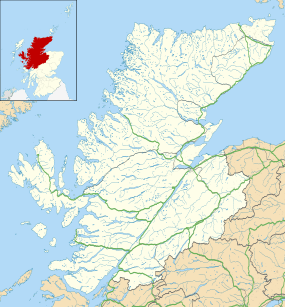Ardvreck Castle
| Ardvreck Castle | |
|---|---|
|
Sutherland in | |
|
Present day ruins of the castle | |
 Ardvreck Castle Location within Highland | |
| Coordinates | 58°09′59″N 4°59′40″W / 58.166389°N 4.994444°WCoordinates: 58°09′59″N 4°59′40″W / 58.166389°N 4.994444°W |
| Site information | |
| Condition | Ruined |
| Site history | |
| Built | 1590 |
| Built by | Clan MacLeod |
| Materials | Stone |
| Fate | Destroyed in 1672 by Clan MacKenzie |
Ardvreck Castle is a ruined castle dating from the 16th century which stands on a rocky promontory jutting out into Loch Assynt in Sutherland, Scotland. One can reach the ruins by driving along the A837 which follows the north shore of Loch Assynt from the village of Inchnadamph. Visitors should take care when walking around the site as falling masonry is a possible danger.
History of Ardvreck
The castle is thought to have been constructed around 1590 by the Clan MacLeod family who owned Assynt and the surrounding area from the 13th century onwards. Indeed Sutherland, the area in which Ardvreck is situated, has long been a stronghold of the Clan MacLeod. The most well known historical tale concerning the castle is that on 30 April 1650 James, Marquis of Montrose was captured by the Laird of Assynt and held at the castle before being transported to Edinburgh for trial and execution.[1] Montrose was a Royalist, fighting on the side of King Charles against the Covenanters. Montrose was executed on 21 May 1650, by hanging, drawing and quartering. Archibald, Marquis of Argyll, a covenanter and Montrose's rival, was himself executed in 1661 after the restoration of the monarchy.[1]
Clan MacKenzie attacked and captured Ardvreck Castle in 1672, and then took control of the Assynt lands. In 1726 they constructed a more modern manor house nearby, Calda House, which takes its name from the Calda burn beside which it stands. A fire destroyed the house under mysterious circumstances one night in 1737 (see below) and both Calda House and Ardvreck Castle stand as ruins today.[2]
Architecture
Ardvreck Castle was a rectangular-shaped keep comprising three storeys. Under the castle the vaulted basement is pierced by gunloops and the round stair turret is corbelled out to support a square caphouse. Despite the small size of the ruined tower, Ardvreck was originally a large and imposing structure and it is thought that the castle included a walled garden and formal courtyard. The remains of the foundations can still be seen and cover a large area. Unfortunately, all that remains today is a tower and part of a defensive wall. When the waters of the loch rise very high, the peninsula on which the castle stands can be cut off from the mainland.
References
- 1 2 Cruwys, Elizabeth; Riffenburgh, Beau (1995). Hicks, Penny, ed. Explore Britain's Castles. Basingstoke, Hampshire: AA Publishing. ISBN 9780749510480.
- ↑ www.lochinver.bordernet.co.uk
- Clan MacLeod, Alan MacNeil, Lomond Books
- Clan MacLeod (Clan History), I.F. Grant, Johnston and Bacon Books